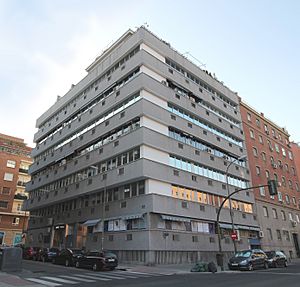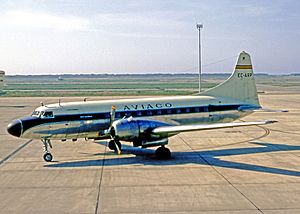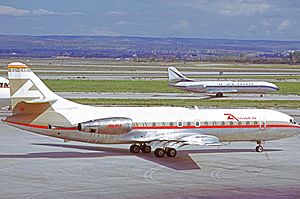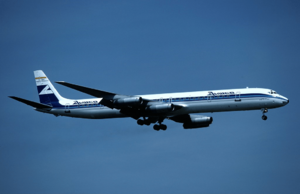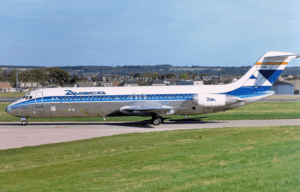Aviaco facts for kids
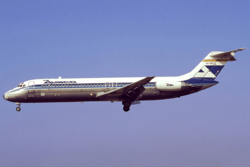 |
|
| Founded | 18 February 1948 |
|---|---|
| Ceased operations | 1 September 1999 |
| Operating bases | Madrid-Barajas Airport |
| Parent company | Iberia |
| Headquarters | Madrid, Spain |
| Key people | Elías Ugartechea Isusi |
Aviaco was a Spanish airline that flew planes for many years. Its full name was Aviación y Comercio, S.A. and its main office was in Madrid, Spain.
Contents
The Story of Aviaco: A Spanish Airline
How Aviaco Started
Aviaco began on February 18, 1948, in Bilbao, Spain. It was started by local business people. At first, it was a company that carried goods, like a cargo airline.
A group of bankers helped by giving money to buy six Bristol 170 planes. Another airline, Iberia, already flew on the most popular routes. So, Aviaco focused on smaller, less busy routes.
Early Flights and Growth
Aviaco soon started flying passengers. Its first passenger flights were between Bilbao, Barcelona, and Madrid. The airline also began flying to other countries. Its first international route was from Algiers to Palma and Marseilles. Soon after, flights to the Canary Islands also started.
In 1954, Aviaco got a special job. It won a contract to carry airmail between Madrid and Barcelona. This helped the company grow even more. In 1955, Aviaco moved its main office from Bilbao to Madrid. A big Spanish company, the Instituto Nacional de Industria (INI), then bought most of Aviaco.
New Planes and Partnerships
In 1959, Aviaco changed how its money was managed. Iberia, the larger airline, invested a lot of money. This made Iberia the owner of two-thirds of Aviaco's shares. This change allowed Aviaco to buy three Convair 440 planes. These were special because they were the airline's first planes with pressurized cabins. This meant passengers could fly higher and more comfortably.
By April 1960, Aviaco had 702 employees. Its fleet included Bristol 170s, Convair 440s, and other planes. It flew to many cities like Barcelona, Brussels, Madrid, and Palma. In 1962, Aviaco bought two Convair 240 planes. In 1964, some of its DC-4 planes were changed into Carvairs. These planes could carry both passengers and cars.
By 1965, Aviaco and Iberia worked even closer. They created a joint board to plan their flights. This made sure that the two airlines did not compete on the same routes.
Expanding the Fleet and Routes
In 1973, Aviaco ordered six McDonnell Douglas DC-9-30 planes. These were popular jets at the time. By March 1975, Aviaco's fleet had grown. It included Caravelle 10Rs, DC-8-50s, DC-9-30s, and F-27s. The airline had 764 employees. Its network of routes covered many Spanish cities like Alicante, Barcelona, Madrid, and Palma. It also flew to Algiers and Oran.
Aviaco continued to buy more DC-9 planes in the late 1970s. The airline faced some financial challenges in 1978 and 1979. However, it made a profit in 1980.
Working with Iberia
By March 1980, Aviaco had over 1,200 employees. The INI still owned most of the company. In the early 1980s, Aviaco started using five DC-8-63 planes. These planes were moved from Iberia's main fleet.
During the 1980s, Iberia bought most of Aviaco's shares. From then on, Aviaco mainly flew on less busy domestic routes. Iberia handled the international flights and the most important national routes, like the shuttle service between Madrid and Barcelona. Aviaco's technical, marketing, and financial teams were moved to Iberia. During this time, Aviaco mostly flew Douglas DC-9 planes, which were painted in blue and white.
Final Years and Merger

In the 1990s, Aviaco added new routes, including flights to London and Paris. By March 1994, Aviaco had 1,696 employees. Its fleet included Fokker F-27s, McDonnell Douglas DC-9s, and MD-88s.
In 1998, Iberia bought all remaining shares of Aviaco, becoming its full owner. Iberia then planned to combine Aviaco with its own operations. This merger happened on September 1, 1999, and Aviaco stopped flying as a separate airline.
Aviaco's Reputation
During its busiest times, Aviaco was known for flying charter flights. These were special flights for tour groups, often from places like Palma and Tenerife to airports across Europe. Many big tour companies used Aviaco.
Aviaco sometimes had a reputation for using older planes, mainly DC-9s, and for having delays. However, many travelers still liked Aviaco. For them, flying with Aviaco became part of their holiday adventure. In the mid-to-late 1980s, Aviaco even used larger planes from Iberia, like Boeing 727s and A300s, for some of its charter flights.
Plane Incidents
Aviaco had some incidents with its planes during its history. Here are some of them:
| Date | Location | Aircraft | Tail number | Aircraft damage | Fatalities | Description | Refs |
|---|---|---|---|---|---|---|---|
| 24 November 1949 | Bristol 170 | EC-ADK | W/O | 0 | The plane went too far off the runway when landing at Mahón Airport. | ||
| 4 December 1953 | Bristol 170 | EC-AEG | W/O | 23/33 | The plane crashed at Guadarrama. It was flying from Bilbao to Madrid. | ||
| 29 September 1956 | SNCASE Languedoc | EC-AKV | W/O | 1 | The plane was flying from Málaga to Tenerife North. It crashed while landing at Los Rodeos Airport, killing one person on the ground. | ||
| 9 May 1957 | Bristol 170 | EC-ADI | W/O | 37/37 | While landing at Madrid-Barajas Airport from Santiago de Compostela, the plane lost control, crashed, and caught fire. All 37 people on board died. | ||
| 14 April 1958 | de Havilland Heron | EC-ANJ | W/O | 16/16 | The plane was flying from Zaragoza to Barcelona. Another plane took off as the Heron was landing. The Heron pilot made a sudden turn, the plane lost power, and fell into the sea. All 16 people on board died. | ||
| 4 December 1958 | SNCASE Languedoc | EC-ANR | W/O | 21/21 | The plane was flying from Vigo to Madrid. It crashed into Sierra de Guadarrama and caught fire, killing all 21 people on board. Ice on the plane was likely the cause. | ||
| 13 August 1973 | Sud Aviation Caravelle | EC-BIC | W/O | 86 | This was one of the deadliest plane crashes in mainland Spain. Aviaco Flight 118 hit trees while landing at A Coruña Airport because of pilot error. It crashed into houses and burned, killing all 85 people on board and one person on the ground. | ||
| 7 December 1983 | DC-9-32 | EC-CGS | W/O | 93 | The Madrid runway disaster happened at Barajas Airport. An Aviaco DC-9-32 was moving on the runway to take off for Santander. At the same time, an Iberia Boeing 727-200 was taking off on the same runway for Rome. The two planes crashed into each other in thick fog. All 42 people on the DC-9 died, and 51 of the 93 people on the Boeing 727 also died. | ||
| 30 March 1992 | DC-9-32 | EC-BYH | W/O | 0 | The plane had a hard landing at Granada Airport. It was flying from Madrid to Granada. | ||
| 21 March 1994 | DC-9-32 | EC-CLE | W/O | 0 | One of the plane's wings hit lights while landing at Vigo Airport. The plane landed short of the runway, causing its main landing gears to break off. It slid for almost 600 meters before stopping. A fire started because of a fuel leak. The plane was flying from Madrid to Vigo. |
See also
 In Spanish: Aviaco para niños
In Spanish: Aviaco para niños
- History of Iberia (airline)
- Transport in Spain


